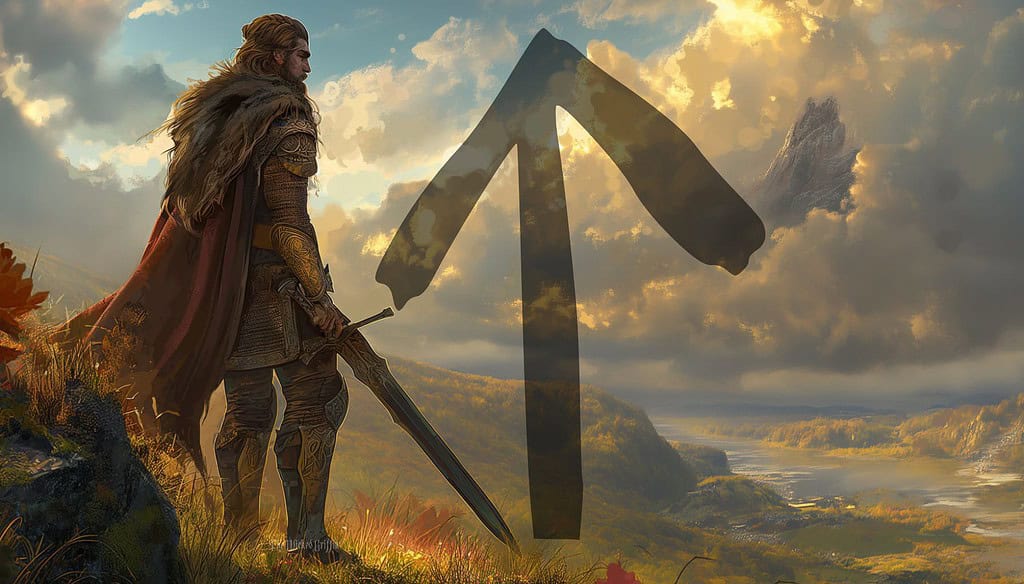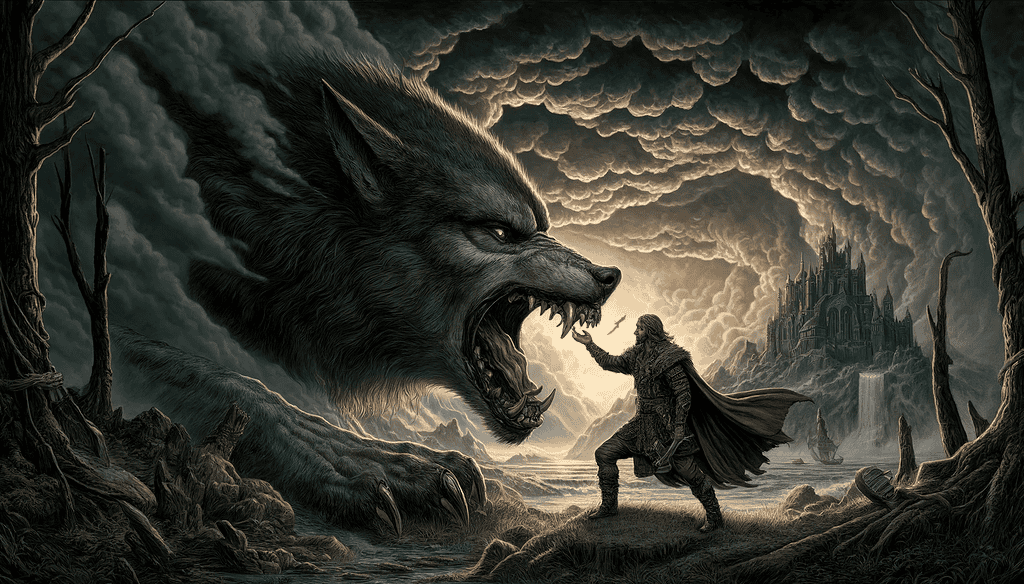The Enigma of Tyr
In the vast and mystical pantheon of Norse gods, Tyr stands out as a figure of justice, courage, and war. Revered across northern Europe, his stories are woven deeply into the fabric of Norse mythology.
This god, who placed his hand in the jaws of the monstrous wolf Fenrir, embodies the ideals of bravery and sacrifice. Tyr’s association with the Tiwaz rune further highlights his significance, linking him to ancient symbols of law and heroic glory.
As we embark on this exploration, we’ll uncover the layers of myth that surround Tyr, delve into his connection with the Tiwaz rune, and recount the legendary tale of his encounter with Fenrir, aiming to provide a rich, engaging experience for enthusiasts of Norse mythology and paganism alike.

Table of Contents
Who is Tyr? – Unraveling the Myth
Tyr stands as a pillar among the Norse gods, revered not only for his martial prowess but also for his judicial wisdom. His role transcends the typical god of war archetype, encompassing the broader dimensions of law and justice that are crucial to understanding Norse societal values.
This exploration delves into Tyr’s complex identity, examining his divine roles and addressing common questions about his relationships with other gods such as Odin and Thor, and his standing as a principal deity of war.
Tyr’s Identity and Divine Roles
Tyr’s portrayal in Norse mythology is multifaceted; he is a god of war, but his domain extends into the realms of justice and legal order, reflecting his importance in maintaining societal balance.
Sources like the Poetic Edda and Prose Edda depict him as a figure of immense courage and moral integrity, highlighting his role in the binding of Fenrir as an example of his commitment to the greater good.
This narrative underscores his significance as a god who is willing to sacrifice for law and order, reinforcing his status not just as a warrior but as a protector of justice.
The Name Tyr and Its Significance
The name “Tyr” is rooted in the Proto-Germanic word *Tîwaz, which is closely linked to the Proto-Indo-European *deiwós, denoting a deity or a celestial being.
This etymological connection emphasizes Tyr’s original prominence as a sky god, illuminating his role in ancient Germanic cultures and his enduring influence in various aspects of life, including his association with the Tiwaz rune.
The name itself symbolizes divine and moral order, further evidenced by its influence on the naming of Tuesday (Tiw’s Day) in the English-speaking world, highlighting the god’s widespread cultural impact.
Comparative Table of Tyr and Other War Gods
| Feature | Tyr (Norse) | Mars (Roman) | Ares (Greek) | Indra (Hindu) |
|---|---|---|---|---|
| Domain | War, Law, and Justice | War, Agriculture, and Fertility | War and Violence | War, Weather, and King of Gods |
| Symbols | Sword, Spear, Tiwaz Rune | Spear, Shield, Wolf, Woodpecker | Spear, Helmet, Dog, Vulture | Vajra (Thunderbolt), Rainbow |
| Day Associated | Tuesday (Tyr’s Day) | Tuesday (named after Mars) | Tuesday (associated with Ares) | None specifically, but festivals often involve martial themes |
| Main Myths | Binding of Fenrir, Loss of Hand | Father of Romulus and Remus, Numerous battles | Battles with Giants, Defense of Olympus | Battles against Vritra, Adventures in the Vedas |
| Character | Just, Brave, Sacrificial | Protective, Aggressive, Strategic | Violent, Unpredictable, Less honored | Heroic, Kingly, Protector of Gods and Humanity |
The Symbolism of the Tiwaz Rune
Overview of the Tiwaz Rune
The Tiwaz rune, deeply entwined with the god Tyr, is a symbol rich in history and significance, representing concepts of law, justice, and warfare across ancient and modern Norse practices. This rune is not only a linguistic token but also a powerful emblem of the values upheld by Tyr himself.
Symbolic Shape and Origins
Its shape—a simple arrow pointing upwards—suggests an assertion towards the sky, resonating with the Proto-Indo-European root *deiwós, which pertains to the sky or celestial being and connotes brilliance or radiance. Historically, the Tiwaz rune was used in various Germanic languages, evolving from the Proto-Germanic *Tîwaz and the Proto-Norse *tīwaʀ.
Uses and Cultural Significance
Its use extends beyond mere writing; it was carved on weapons, amulets, and rune stones as a charm for victory in battle or for judicial purposes, embodying Tyr’s qualities as a war god and a deity of legal order. The presence of this rune in inscriptions suggests that it was a potent symbol for invoking divine help in legal and martial matters.
Modern Relevance and Practices
In contemporary Norse paganism and among enthusiasts of Norse mythology, the Tiwaz rune retains its symbolic meanings. It is frequently used in modern rune readings, reflecting enduring themes of justice and ethical conduct, which are as relevant today as they were in Viking times. The rune encourages reflection on fairness, right action, and the warrior’s path, which are intrinsic to the moral compass of Norse cultural heritage.
Connecting with Ancient Traditions
As we explore the implications of the Tiwaz rune, we connect with the ancient practices that have influenced Northern European spiritual traditions. This exploration not only enriches our understanding of Tyr’s symbolic universe but also invites us to integrate these enduring values into our own lives, demonstrating the timeless relevance of these ancient symbols.

The Tale of Tyr and Fenrir
The story of Tyr and Fenrir is one of the most poignant tales within Norse mythology, encapsulating themes of sacrifice, bravery, and the profound nature of binding agreements. This narrative not only highlights Tyr’s role as a god of war and justice but also emphasizes his incredible courage and the deep trust placed in him by the other gods.
The Binding of Fenrir
The saga of the binding of Fenrir sets the stage for Tyr’s ultimate act of valor. As the gods realized that Fenrir the wolf was growing too powerful and dangerous, they decided to bind him. However, Fenrir was suspicious and would only allow the gods to bind him if one of them placed their hand in his mouth as a pledge of good faith.
Tyr, known for his bravery and sense of justice, was the only god willing to fulfill this perilous role. This act was not just about bravery; it was a demonstration of Tyr’s commitment to maintaining order and protecting the worlds from chaos.
Tyr’s Bravery and Sacrifice
Reflecting on Tyr’s sacrifice, it’s clear that his decision to place his hand in Fenrir’s mouth was a pivotal moment in Norse myth. When Fenrir found that he could not break free from the magical bindings, he bit off Tyr’s hand, leaving the god permanently maimed.
This act of sacrifice significantly enhanced Tyr’s reputation among the Norse gods and humans alike. Tyr’s loss of his hand is rich in symbolic meaning, illustrating themes of sacrifice for the greater good and the irreversible nature of true commitment.
His willingness to lose a part of himself for the safety of others embodies the ideals of heroism and leadership valued in Norse culture. This story continues to resonate as a powerful example of ethical leadership and the heavy costs that sometimes come with it.
Prelude to Ragnarok: The Lasting Consequences of Sacrifice
This grievous event also set a series of further tumultuous events into motion, contributing indirectly to the onset of Ragnarok, the apocalypse in Norse cosmology. The betrayal perceived by Fenrir would later fuel his fury and participation in the great battles of Ragnarok, where gods and monsters meet their fate.
Tyr’s sacrifice, therefore, is not just a narrative of personal loss and heroism but also a critical precursor to the end of the world as foretold by the ancient Norse, illustrating the interconnectedness of trust, betrayal, and cosmic destiny in Norse myths.

Tyr’s Relationships and Rivalries
Tyr’s interactions with other figures in Norse mythology are as compelling as his tales of bravery and justice. His relationships and rivalries with gods and mythical creatures shed light on his complex role within the Norse pantheon, particularly regarding his connections with Odin and his position in Norse cosmology.
Tyr and Odin – A Relationship of Respect and Rivalry
The dynamics between Tyr and Odin are fascinating, reflecting a mix of mutual respect and underlying rivalry. While Odin is often considered the chief god of the Norse pantheon, renowned for his wisdom and shapeshifting abilities, Tyr’s role as a war god and a deity of justice positions him as a significant figure in his own right.
Questions often arise about Tyr’s lineage, with some sources hinting at him being a son of Odin, which suggests a familial tie that adds depth to their interactions.
This relationship is crucial in understanding the distribution of roles and powers among the Norse gods, illustrating the balance between wisdom and justice.
The source claiming Tyr might be Odin’s son comes from Norse mythology itself, but there’s a bit of a twist.
- Snorri Sturluson: The Prose Edda, written by Snorri Sturluson in the 13th century, identifies Tyr as Odin’s son. This is the most widely cited source for this claim.
- Hymiskviða: However, the Eddic poem Hymiskviða presents a different view. Here, Tyr is referred to as the son of the giant Hymir.
This inconsistency creates a debate among scholars. Some believe Snorri misinterpreted information, while others see it as a possibility that Tyr had dual parentage or was fostered by Hymir.
Tyr’s Interactions with Other Deities and Creatures
Beyond Odin, Tyr’s relationships extend to other deities and legendary creatures, each underscoring different facets of his character. Unlike his bond with Odin, Tyr’s interactions with Fenrir—the giant wolf—are marked by a tragic but necessary betrayal that highlights Tyr’s dedication to the greater good.
This event is pivotal not only in Tyr’s mythology but also in illustrating his moral and ethical stance, even when it leads to personal loss.
Tyr’s role in Norse cosmology cannot be overstated. He is often depicted as a stabilizing figure among the gods, one who enforces laws and oaths, which are integral to maintaining order in the universe.
His relationships, whether marked by kinship, rivalry, or sacrifice, reflect his importance in Norse myths, showing him as a god who deeply influences the mythical narratives and the overarching cosmological ideologies of the Norse world.

The Influence of Tyr in Germanic Traditions
Tyr’s influence extends far beyond the Norse myths into broader Germanic traditions, where his presence and impact can be traced in various cultures across Northern Europe. This section explores how Tyr’s attributes and stories resonate within these traditions, highlighting his connections to gods in related mythologies and illustrating the breadth of his significance.
Etymological Roots and Early Worship
The roots of Tyr are deeply entwined with the Proto-Germanic *Tîwaz, derived from the Proto-Indo-European *deiwós, which indicates a deity associated with the sky and celestial phenomena.
This etymological background suggests that Tyr was once a chief deity among the Germanic tribes, much before Norse mythology crystallized into the form we recognize today. His role as a god of war and justice was pivotal in these societies, where the legal and martial prowess dictated the societal order and stability.
Connections with Other European Deities
In examining Tyr’s influence across Germanic traditions, it’s evident that he shares characteristics with gods from other European pantheons. For instance, his function as a war god and a divine jurist has parallels with deities such as Mars in Roman mythology and even aspects of Zeus in Greek mythology.
However, Tyr’s portrayal as a binding figure, someone who sacrifices for the greater good, offers a unique perspective on leadership and justice that is distinctively Germanic.
Artifacts and Pan-Germanic Worship
The widespread veneration of Tyr across different Germanic groups also influenced local practices and beliefs. His name and attributes are reflected in various artifacts and inscriptions, suggesting that his worship was not confined to the Norse but was a pan-Germanic phenomenon.
These artifacts often carry symbols like the Tiwaz rune, affirming his continued relevance in the spiritual and daily lives of these ancient peoples.
This exploration of Tyr’s influence in Germanic traditions not only highlights his importance in Norse mythology but also underlines his role as a trans-cultural figure who embodies the values of justice, bravery, and sacrifice across ancient Northern Europe.
His legacy in these traditions provides a comprehensive understanding of his role in shaping early European cultural and religious landscapes.

Questions and Misconceptions about Tyr
In the rich tapestry of Norse mythology, Tyr is a figure shrouded in valor and mystery, often leading to a variety of questions and misconceptions about his role and characteristics. This section aims to clarify these uncertainties, providing well-researched insights into Tyr’s character and his significance within the Norse pantheon.
Is Tyr the Son of Odin?
One common question concerns Tyr’s parentage, specifically whether he is the son of Odin. Historical sources vary on this point.
While some later sources suggest Tyr is the son of Odin, other ancient texts, like those found in the older Eddas, do not explicitly state this relationship. This ambiguity reflects the fluid nature of mythological narratives, where relationships and roles can evolve across different texts and traditions.
Was Tyr Feared by Odin?
Another intriguing aspect is whether Odin, the chief of the Norse gods, feared Tyr. This idea stems from interpretations of the mythological dynamics where Tyr’s unwavering adherence to justice and his willingness to make personal sacrifices could be seen as embodying ideals that even Odin, with all his wisdom and power, might find daunting.
However, there are no direct references in the primary mythological texts that explicitly state Odin feared Tyr, suggesting this might be a modern interpretation.
Why Did Tyr Sacrifice His Hand?
The tale of Tyr sacrificing his hand to Fenrir is central to his mythos. This act is often misunderstood merely as a loss or defeat. In reality, this sacrifice symbolizes Tyr’s deep commitment to order and stability in the cosmos.
By placing his hand in Fenrir’s mouth, Tyr was not only upholding a promise but also demonstrating profound bravery and a commitment to the greater good, qualities that defined his role as a god of war and justice.
Is Tyr Only a War God?
While Tyr is widely recognized as a god of war, labeling him solely as such oversimplifies his role. He was also a god of law, justice, and oaths. This broader understanding of his divine responsibilities highlights Tyr’s integral role in maintaining social order and moral law, which is sometimes overshadowed by his martial aspects.
Addressing these questions and clarifying misconceptions allows for a deeper appreciation of Tyr’s complex nature and his pivotal role in Norse mythology, enriching the understanding of his enduring legacy and influence.
Reflecting on Tyr’s Legacy
Tyr’s enduring influence stretches from the ancient runic inscriptions to modern depictions in media and literature, underscoring his multifaceted role in Norse mythology. His association with the Tiwaz rune, a symbol of justice and honor, continues to inspire those who study ancient scripts and those who practice modern paganism.
As we explore Tyr’s narratives, from his sacrifices to his roles as a war and law god, we gain deeper insights into the values that shaped Norse cultural heritage. These stories encourage us to reflect on the virtues of bravery and fairness that Tyr epitomized, inviting us to consider how such timeless qualities influence our understanding of history and morality today.

